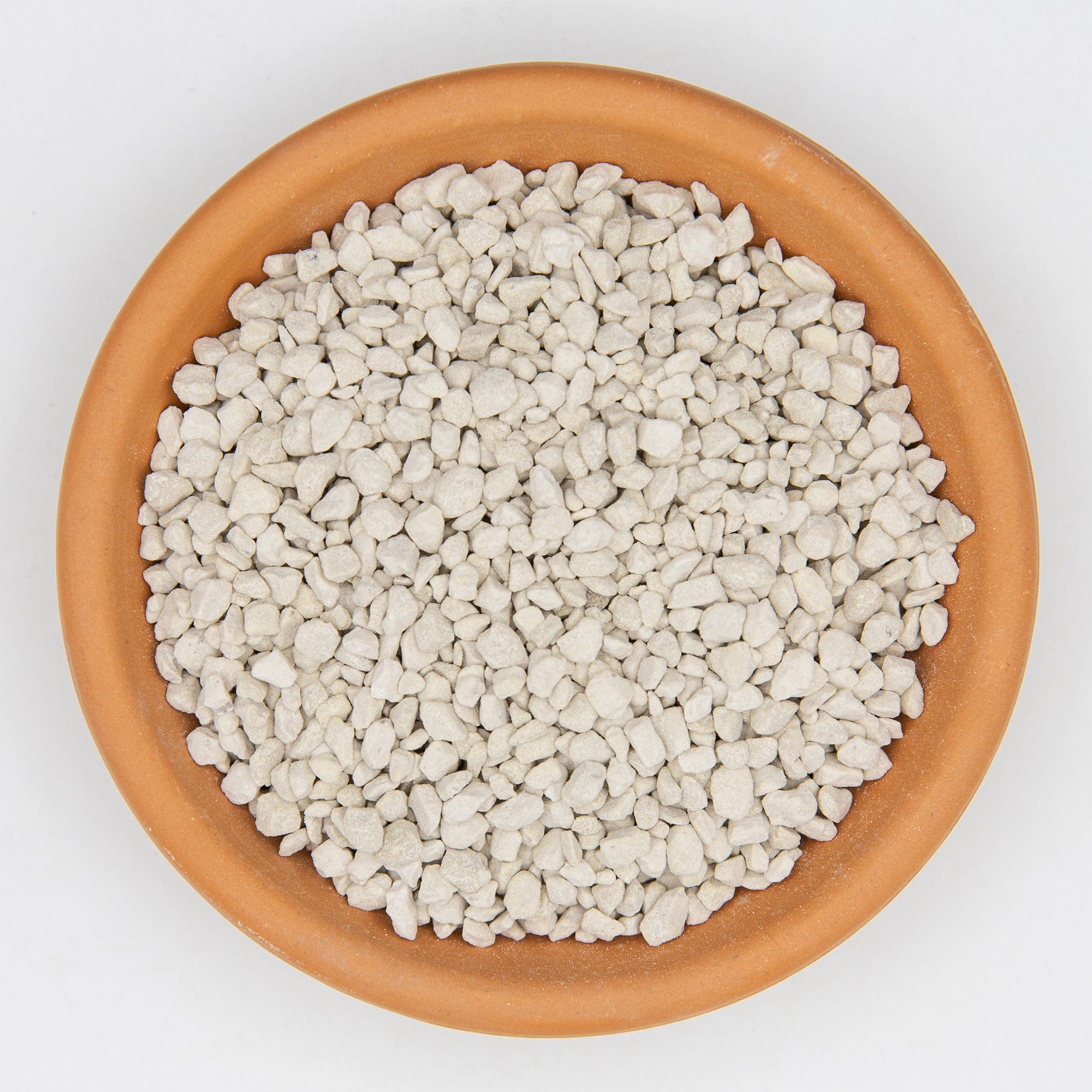Potash (potassium sulphate) is used to create potassium rich fertilizer blends and is frequently used as a potassium supplement for soil and hydroponic gardening. Potassium is a crucial component needed for healthy plant development and growth. SOP has a reputation for enhancing the general health and productivity of plants, especially when combined with other fertilizers in a balance NPK ratio.
Potash contains soluble potassium, making it an excellent addition to gardening fertilizer. It ensures proper maturation in a plant by improving overall health, root strength, disease resistance, and yield rates. In addition, potash creates a better final product, improving the color, texture, and taste of food.
Potash is the perfect amendment for fruiting and flowering plants!
Use at 10g per 30L of potting soil for heavy fruiting varieties.
Contains 18% Sulphur
Other advantages:
- It is high in potassium, which is an important nutrient that is needed for healthy plant development and growth.
- Is commonly used to easily increase the soil's potassium content.
- Potash be used to drastically raise yields and general health in fruiting and flowering plants.
- It is used to increase resistance to drought.
FAQs:
What exactly is this Potash?
A sulfate of potash (potassium sulfate, K₂SO₄) granular amendment that delivers potassium (K) plus sulfur (S). It’s chloride-free, so it’s gentle on salt-sensitive crops and great for fruiting/flowering stages.
What’s the NPK and what else is inside?
NPK is 0-0-41 with ~18% sulfur. No nitrogen or phosphorus—this is a straight K booster.
When should I use Potash?
Anytime you need extra potassium: pre-plant soil builds, at first flower/fruit set, and during heavy fruit fill. It’s especially handy if you’ve used lots of nitrogen early and want to balance the crop later.
How much should I use in pots or raised beds?
As a rule of thumb for heavy fruiters: 10 g per 30 L of potting mix. That’s ~5 g for a 15 L pot, ~33 g per 100 L of soil. Mix into the top 3–5 cm and water in well.
Can I side-dress existing plants?
Yep. Scratch a light sprinkle into the surface around the drip line (think “salt on chips,” not “sand on the beach”), then water in. Reapply lightly every 4–6 weeks in peak fruiting if the crop is demanding.
Can I dissolve Potash and feed through water?
You can—K₂SO₄ is water-soluble—just premix in a bucket until dissolved and avoid dumping granules straight into irrigation lines. If you’re running hydro/fertigation, add it to the reservoir after your base nutrients and measure EC; it’s easy to overshoot with pure K.
Is Potash safe for hydroponics?
Yes, but dose by targets (EC/ppm and tissue/leaf tests) rather than teaspoons. Start low, watch your K:Ca:Mg balance, and avoid clogging by fully dissolving before it hits the system.
Which plants benefit most?
Tomatoes, capsicum/chillies, cucumbers, berries, grapes, citrus, bananas, roses—any crop where bloom quality, fruit size, color, and shelf life matter. It’s also a good pick for chloride-sensitive plants.
Will Potash help with yellowing or burnt leaf edges?
If the cause is potassium deficiency—classic signs are marginal scorch/browning on older leaves, weak stems, poor flowering/fruit set—then yes, potassium can correct it. If the issue is something else (e.g., salt burn, drought, disease), fix that first.
How do I know if my plants are low on potassium?
Look for older leaves with yellowing along the edges that turns brown and crispy, curling margins, weak stems, and lackluster flowering/fruiting. A soil or leaf test is the gold standard.
Can I overdo Potash? What happens if I apply too much?
Yes. Excess K can crowd out magnesium and calcium uptake, leading to interveinal chlorosis (Mg) or blossom-end rot/tip burn (Ca) even when those nutrients are present. Keep applications modest and balanced.
How does this differ from “muriate of potash” (KCl)?
This product is sulfate of potash (SOP), not muriate (MOP). SOP is chloride-free and lower salt index—better for sensitive crops and quality. MOP is cheaper but adds chloride, which some crops dislike.
Is Potash “organic”?
Potassium sulfate from mined sources can be approved under many organic standards, but certification is product-specific. Ours is sold for organic-style gardening; if you’re certified organic, check with your certifier and look for the appropriate listing on the exact batch/label.
Does Potash change soil pH?
Slightly acid-forming over time (handy in alkaline mixes). In most potting blends the effect is mild; in very acidic soils, pair with dolomite/lime as needed per soil test.
Can I use Potash with TurboDirt, compost, or other DRGT amendments?
Yes—TurboDirt and quality compost supply base K, but heavy fruiters often want more during bloom/fruit set. Layer Potash lightly on top of your usual program; don’t replace your full-spectrum nutrition.
Will Potash play nice with Cal-Mag?
Mostly yes, but don’t stack big doses at the same time. Keep K additions moderate and maintain a sensible K:Ca:Mg balance. If you push K hard, expect to supplement Mg/Ca or back off the K.
Is foliar spraying a good idea?
We generally recommend soil/solution feeding. If you choose to foliar, spot-test first with a very dilute mix and spray at lights-off/late afternoon to avoid leaf scorch.
Can I use Potash on lawns and ornamentals?
Absolutely. A light application can improve turf stress tolerance and color and beef up flowering in ornamentals.
How fast does Potash work?
You’ll typically see improved turgor and flower/fruit quality over 1–3 weeks, but structural improvements (root strength, stress tolerance) accrue over the season.
Any compatibility gotchas?
Avoid dumping granules into concentrated stock tanks—pre-dissolve. Don’t blend dry with strongly alkaline materials in storage (risk of caking). In feed water, add after calcium nitrate to reduce precipitation risk.
Storage and shelf life?
Keep it bone-dry, sealed, and off the floor. It stores indefinitely if it stays dry; humidity can cause caking—still usable, just crush and dissolve.
Is Potash safe around pets and kids?
It’s a mineral fertilizer—not for ingestion. Store securely and sweep up spills. Rinse skin/eyes if contacted; seek medical advice if swallowed.
Can I combine Potash with DRGT Pro PK or other bloom boosters?
Yes, but be purposeful. If you’re already running a PK booster, your K may be covered—check labels and avoid stacking high-K products blindly. Use Potash to correct a known K gap or when you want a chloride-free K bump without extra phosphorus.
What if I’m unsure how much my crop actually needs?
Run a soil test (and/or leaf test mid-season). Target your K to crop demand and media type, then make small adjustments rather than big swings.
What size should I buy?
If you’re growing a handful of fruiters, 1 kg goes a long way—remember, you’re dosing in grams per pot, not handfuls.
Will Potash stain paving or decks?
It can leave mineral marks if left wet. Sweep up and hose down the area after application.
Does Potash help with drought or heat stress?
Adequate K improves stomatal control and water-use efficiency, so plants handle heat/dry spells better. It’s not a magic shield, but it stacks the odds in your favor.
Can I use Potash for indoor houseplants?
For blooming houseplants (e.g., hoya, hibiscus), a pinch goes a long way. Most foliage-only houseplants don’t need extra K unless you’ve been pushing nitrogen hard.
What’s the quick-start recipe for tomatoes in 30 L pots?
Mix ~10 g into the top of each pot at first truss, water in, then repeat lightly at early fruit fill if needed. Watch leaves and fruit; add more only if plants ask for it.
I used Potash and now I’m seeing interveinal yellowing. What gives?
Classic sign of magnesium shortfall, often from pushing K too hard. Ease back on K and add a touch of Mg (e.g., Epsom salts) per label.
Is there chlorine in this?
No—this is sulfate of potash, not muriate. That’s the whole point.
Why is your analysis 0-0-41 when other SOP bags say 0-0-50?
Analyses vary by source/granulation. Ours is formulated/labelled at 41% K (with ~18% S). Dose to effect, not what someone else’s bag says.
Any tips to keep it simple and avoid mistakes?
Start small, stay consistent, and let tests and plant feedback guide you. Potash is powerful—treat it like a scalpel, not a shovel.



